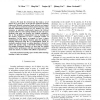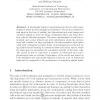425 search results - page 63 / 85 » Using Stochastic Grammars to Learn Robotic Tasks |
IROS
2009
IEEE
14 years 3 months ago
2009
IEEE
— Many everyday human skills can be framed in terms of performing some task subject to constraints imposed by the environment. Constraints are usually unobservable and frequently...
ICDM
2010
IEEE
13 years 6 months ago
2010
IEEE
We study the retrieval task that ranks a set of objects for a given query in the pairwise preference learning framework. Recently researchers found out that raw features (e.g. word...
MIRRORBOT
2005
Springer
14 years 2 months ago
2005
Springer
Abstract. A biologically inspired computational model of rodent representation–based (locale) navigation is presented. The model combines visual input in the form of realistic tw...
AR
2006
13 years 8 months ago
2006
The development and expression of many higher level cognitive functions, such as imitation, spatial perception, and tool-use relies on a multi-modal representation of the body kno...
CVPR
2010
IEEE
14 years 5 months ago
2010
IEEE
We present an algorithm that learns invariant features from real data in an entirely unsupervised fashion. The principal benefit of our method is that it can be applied without hu...



